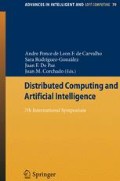Abstract
In this paper an iconic notation for describing the composition between the relations of a new qualitative representation model based on trajectories in two dimensions is presented. This qualitative representation model represents a new intuitive approach for describing the spatiotemporal features of two mobile entities through the relations between its trajectories. In order to describe the composition between relations in terms of a transitivity operation, an iconic notation derived from the Conceptual Neighborhood Graph is provided. Finally, in order to illustrate this iconic notation, some examples of composition between relations are presented.
Access this chapter
Tax calculation will be finalised at checkout
Purchases are for personal use only
Preview
Unable to display preview. Download preview PDF.
References
Cohn, A.G., Bennett, B., Gooday, J., Gotts, N.M.: Representing and Reasoning with Qualitative Spatial Relations about Regions. In: Stock, O. (ed.) Spatial and Temporal Reasoning, pp. 97–134. Kluwer Academic Publishers, Dordrecht (1997)
Egenhofer, M.: Reasoning about Binary Topological Relations. In: Günther, O., Schek, H.-J. (eds.) SSD 1991. LNCS, vol. 525, pp. 143–160. Springer, Heidelberg (1991)
Freksa, C.: Temporal Reasoning Based on Semi-Intervals. Artificial Intelligence 54, 199–227 (1992a)
Freksa, C.: Using orientation information for qualitative spatial reasoning. In: Frank, M.A., Campari, I., Formentini, U. (eds.) Theories and Methods of Spatio-temporal Reasoning in Geographyc Space, pp. 162–178. Springer, Berlin (1992b)
Freksa, C., Zimmermann, K.: On the utilizacion of spatial structures for cognitively plausible and efficient reasoning. In: IEEE international Conference on Systems, Man and Cybernetics, pp. 261–266. IEEE press, Los Alamitos (1992)
Hernández, D.: Qualitative Representation of Spatial Knowledge. LNCS, vol. 804. Springer, Heidelberg (1994)
Randell, D.A., Cohn, A.G.: Modelling Topological and Metrical Properties of Physical Processes. In: Brachman, R., Levesque, H., Reiter, R. (eds.) Proceedings of the 1st International Conference on Principles of Knowledge Representation and Reasoning (KR), Toronto, Canada, pp. 55–66. Morgan Kaufmann, San Francisco (1989)
Moratz, R.: Representing relative direction as a binary relation of oriented points. In: Brewka, G., et al. (eds.) ECAI 2006: 17th European Conference on Artificial Intelligence, pp. 407–411. IOS Press, Amsterdam (2006)
Van de Weghe, N., Kuijpers, B., Bogaert, P., De Maeyer, P.: Qualitative Trajectory Calculus and the composition of its relations. In: Rodríguez, M.A., Cruz, I., Levashkin, S., Egenhofer, M.J. (eds.) GeoS 2005. LNCS, vol. 3799, pp. 60–76. Springer, Heidelberg (2005)
Zimmermann, K., Freksa, C.: Enhancing Spatial reasoning by the Concept of Motion. In: Sloman, A., Hogg, D., Humphreys, A., Ramsay, A., Partridge, D. (eds.) Proceedings of AISB. Prospects in Artificial Intelligence, pp. 140–147. IOS-Press, Amsterdam (1993)
Zimmermann, K., Freksa, C.: Qualitative spatial Reasoning using orientation, distance and path Knowledge. Applied intelligence 6, 49–58 (1996)
Author information
Authors and Affiliations
Editor information
Editors and Affiliations
Rights and permissions
Copyright information
© 2010 Springer-Verlag Berlin Heidelberg
About this paper
Cite this paper
González-Cabrera, F.J., Serrano-Montero, M., Peris-Broch, J.C., Escrig-Monferrer, M.T., Álvarez-Bravo, J.V. (2010). An Iconic Notation for Describing the Composition between Relations of a Qualitative Model Based on Trajectories. In: de Leon F. de Carvalho, A.P., Rodríguez-González, S., De Paz Santana, J.F., Rodríguez, J.M.C. (eds) Distributed Computing and Artificial Intelligence. Advances in Intelligent and Soft Computing, vol 79. Springer, Berlin, Heidelberg. https://doi.org/10.1007/978-3-642-14883-5_84
Download citation
DOI: https://doi.org/10.1007/978-3-642-14883-5_84
Publisher Name: Springer, Berlin, Heidelberg
Print ISBN: 978-3-642-14882-8
Online ISBN: 978-3-642-14883-5
eBook Packages: EngineeringEngineering (R0)

